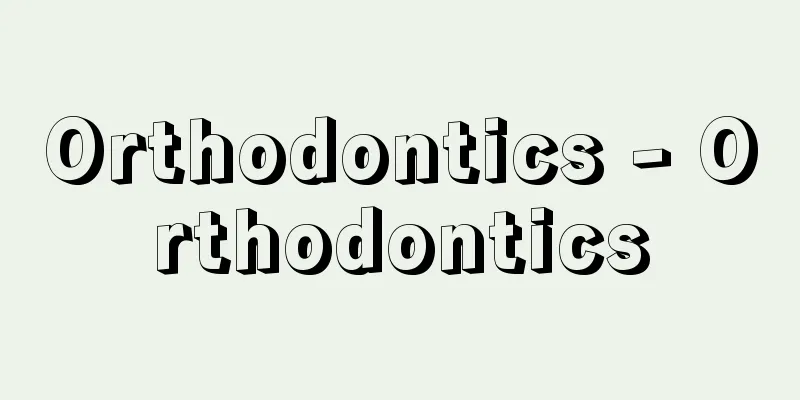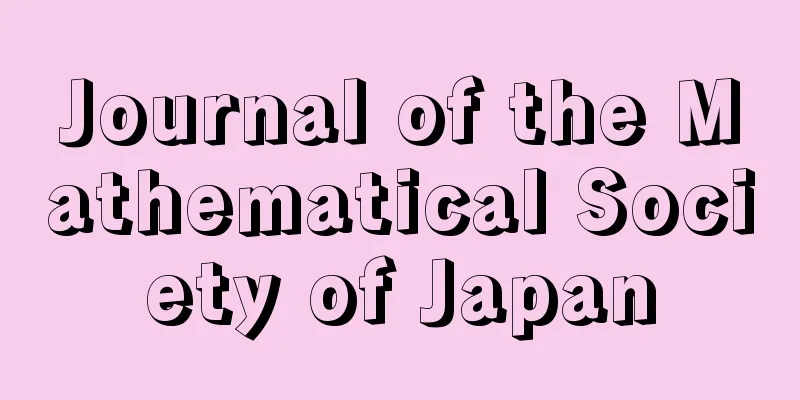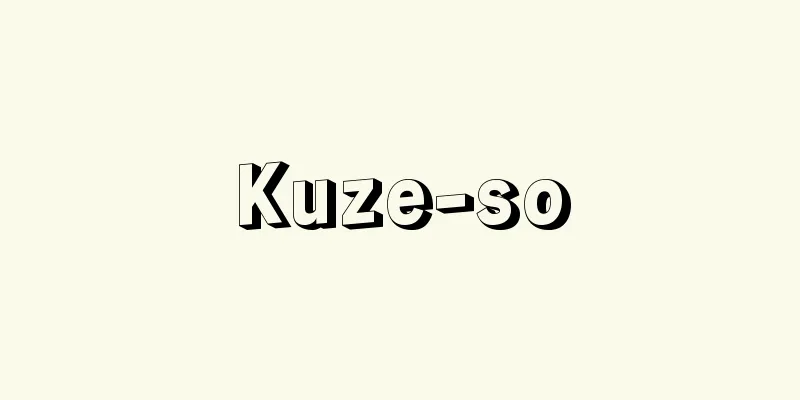Orthodontics - Orthodontics

|
When there is a morphological or functional abnormality in the face, jaw, or teeth that prevents a normal occlusion (malocclusion), the physiological and psychological disorders caused by this are eliminated by applying an appropriate force (orthodontic force) to the teeth and jawbone to improve their position and bring about a normal occlusion or a state close to it. When an appropriate load is continuously applied to the alveolar bone through the teeth, new addition of periodontal ligament and alveolar bone occurs on the compressed side, resulting in tooth movement. Thus, in orthodontic treatment, it is necessary to apply load in a certain direction to the teeth and jawbone, and these loads are collectively called orthodontic forces. Orthodontic forces can be broadly divided into those caused by mechanical forces and those caused by muscle forces. Mechanical forces include those caused by the elasticity of metal wires such as elastic wires and coil springs, those caused by the elasticity of rubber, and those caused by connections with rigid bodies (such as thick wires). Methods that use muscle power include so-called functional orthodontic devices that are placed in the mouth and utilize the pressure of the lips and orbicularis oris muscles, and so-called myofunctional therapy, which utilizes the functional power of special muscles. [Nobuko Ichimaru] Orthodontic appliances and treatmentThere are two types of orthodontic appliances: fixed, which cannot be removed by the patient, and removable, which can be removed; however, the fixed type is the most commonly used. Typical fixed appliances include archwire appliances, which attach a wire about 1 mm in diameter to the labial side, lingual side, or both, and apply force to the teeth using elastic wire or rubber attached to it, and full-band appliances, which attach metal bands to all teeth, to which wires, springs, or rubber are attached, and apply force to the teeth. Recently, instead of metal bands, only small metal fittings have been attached to the tooth surface with a special adhesive, improving aesthetics. Orthodontic treatment requires accurate diagnosis of the cause, type, and severity of malocclusion, as well as prediction of jaw and facial growth. If there is constant inappropriate external force on the teeth and jaw due to bad oral habits, the first step in orthodontic treatment is to remove it. Even for the same type of malocclusion, the treatment method varies depending on the cause. For example, in maxillary prognathism, when the maxillary bone itself protrudes, a device attached to a kind of cap is used to continuously hold down the maxillary bone and suppress its growth, but if the maxillary bone is in a normal position but the maxillary front teeth are inclined toward the lip, treatment is performed by moving the teeth. In mandibular prognathism, the cause can be abnormal position of the maxilla or mandible, or abnormal position of the entire mandibular dentition, and the latter is more difficult to treat. The growth of the jawbone varies depending on gender and individual, but generally, the period of most rapid growth is between 10 and 15 years old, and if this period is missed, applying orthodontic force to the jawbone is often meaningless. Malocclusion can also occur when there is a discrepancy between the sum of the crown widths of the erupted teeth (the overall width of the teeth) and the space in the jaw where the teeth are arranged. For example, if a baby molar becomes carious and is lost early, the first molar moves forward, leaving insufficient space for the permanent teeth, resulting in malocclusion such as crooked teeth or crooked teeth. In such cases, the first molar is moved backwards using an orthodontic appliance, but if there is still insufficient space, the first or second premolar is conveniently extracted to secure the space, and then the individual teeth are moved to normal occlusion. In addition, if there are superfluous teeth, there will also be insufficient space in the jaw, resulting in malocclusion. If there are superfluous teeth in the upper anterior region, they can cause midline diastema (a condition in which the left and right central incisors erupt apart), so it is necessary to remove such superfluous teeth early. [Nobuko Ichimaru] Timing of treatmentOrthodontic treatment is closely related to the growth of the jaw, face, and skull, so it is best to begin treatment as early as possible once you notice that your teeth are misaligned. Generally, treatment is most often started when baby teeth are replaced by permanent teeth (around age 10). This is the so-called orthodontic age, as the permanent teeth begin to erupt and the condition of the teeth becomes evident, and it is also before the rapid growth of the jawbone begins. However, orthodontic treatment is possible even in adults in some cases. The time required for orthodontic treatment varies considerably depending on the symptoms, but it can take at least one year and up to five years. This is because to move the teeth smoothly, the treatment must be done at a slow pace of 1-2 mm per month, and a period of adjustment and observation is required to stabilize the tooth alignment and bite state achieved by orthodontic treatment. Achieving a stable state is called "retention," and can be divided into mechanical retention using devices and natural retention without devices. Orthodontic treatment other than that for malocclusion due to cleft lip or palate is subject to elective medical treatment and is not covered by health insurance, so it requires a considerable amount of money. In addition, wearing orthodontic appliances in the mouth for a long period of time can reduce the self-cleaning ability of the mouth, induce caries and periodontal disease, and cause root resorption due to excessive orthodontic force, so it is also necessary to take regular measures to prevent malocclusion, such as preventing the early loss of baby teeth. [Nobuko Ichimaru] [Reference] | |Source: Shogakukan Encyclopedia Nipponica About Encyclopedia Nipponica Information | Legend |
|
顔面、あご、歯などに形態や機能の異常があり、正常な咬合(こうごう)(かみ合せ)が営みえないとき(不正咬合)、それがもたらす生理学的、心理学的な障害を取り除くため、歯や顎骨(がくこつ)に適当な力(矯正力)を加えてそれらの位置を改善し、正常咬合もしくはそれに近い状態に導くことをいう。歯を介して歯槽骨に適当な荷重を持続的に加えると、圧迫された側では歯根膜や歯槽骨の新生添加がおこり、結果として歯は移動する。このように、矯正治療においては歯や顎骨にある方向の荷重を加える必要があり、これらの荷重を総称して矯正力という。矯正力は、器械力によるものと、筋肉の力によるものとに大別できる。器械力には、弾線、コイル・スプリングなどの金属線の弾力によるもの、ゴムの弾力によるもの、剛体(たとえば太いワイヤ)との連結によるものなどがある。筋肉の力によるものには、いわゆる機能的矯正装置を口腔(こうくう)内に入れ、口唇や口輪筋の圧力を利用するものと、特殊な筋の機能力を利用するいわゆる筋機能療法とがある。 [市丸展子] 矯正装置と治療矯正装置には、患者自身では取り外しのできない固定式のものと、取り外しのできる可撤式のものとがあるが、固定式のものが多く用いられる。固定式のものでは、唇側、舌側またはその両方に直径約1ミリメートルのワイヤを固定し、それに取り付けた弾力線やゴムの力を歯に加える弧線装置と、全部の歯に金属のバンド(帯環)をつけ、これにワイヤやスプリング、ゴムを取り付け、その力を歯に加える全帯環装置が代表的なものである。最近では、金属のバンドのかわりに小さな金具のみを特殊な接着剤で歯面に接着するようになり、審美性がよくなっている。 歯列矯正を行うにあたっては、不正咬合の原因、種類、程度のほか、あご・顔面の成長予測といった面からも正確な診断が要求される。口腔悪習慣等によって歯や顎骨に不適当な外力が絶えず加わるようなことがあれば、まずそれを取り除くことが、歯列矯正の第一歩である。同じ型の不正咬合でも、その原因によって治療方法は異なる。たとえば、上顎前突で、上顎の骨自体が突き出ている場合には、一種の帽子に取り付けた装置で持続的に上顎骨を押さえて成長を抑制するが、上顎骨の位置は正常でも、上顎前歯が唇側に傾斜している場合には、歯を移動することによって治療する。また、下顎前突(うけ口)においては、その原因が、上顎または下顎の位置異常によるものと、下顎歯列全体の位置異常によるものとがあるが、後者のほうが治療法はむずかしくなる。なお、顎骨の成長は、男女、個人による差があるが、一般に10~15歳が成長の著しい時期で、この時期を逸すると顎骨に矯正力を加えても意味をなさないことが多い。 萌出(ほうしゅつ)している歯の歯冠幅径の和(歯全体の横幅の長さ)と、歯が配列する顎骨のスペース(間隔)に不調和が存在しても、歯列不正の原因となる。たとえば乳臼歯(にゅうきゅうし)がう蝕(しょく)(むし歯)となって早期に喪失した場合、第一大臼歯が前方に移動して、永久歯のためのスペースが十分にとれなくなり、八重歯やいわゆる乱ぐい歯などの歯列不正が生じてくる。こういう場合には、第一大臼歯を矯正装置によって後方へ移動するが、それでもなおスペースに不足が生じる場合には、第一または第二小臼歯を便宜的に抜去してスペースを確保したうえで、個々の歯を移動して正常咬合へ導くことになる。また、過剰歯がある場合にも、やはり顎骨のスペースに不足が生じ、歯列不正となる。上顎前歯部に過剰歯があると、正中離開(左右中切歯が離れて萌出している状態)の原因となるので、このような過剰歯は早期に抜去することが必要である。 [市丸展子] 治療の時期歯列矯正は、あご、顔面、頭蓋(とうがい)各部の成長と深い関連があるので、歯列不正に気づいた時点で、なるべく早期に治療を始めたほうがよい。一般的には、乳歯から永久歯に生え替わる時期(10歳前後)が治療の時期となることが多い。この時期は、永久歯が萌出し始め、歯列不正の状況がはっきりしてくるうえに、顎骨の急速な成長が始まる前でもあるので、いわゆる矯正年齢とよばれる時期である。しかしながら、成人であっても症例によっては矯正治療は可能である。 歯列矯正に要する期間は、症状によってかなりの違いはあるが、少なくとも1年以上、長いと5年以上にわたることがある。歯を無理なく移動するには、1か月間に1~2ミリメートルのゆっくりしたペースで行わねばならないことと、歯列矯正によって得られた歯列や咬合状態を安定な状態にするための調整・観察期間が必要となるためである。安定な状態にすることを「保定」とよび、装置を用いて行う器械的保定と、装置を用いない自然保定とに分けられる。 なお、唇裂、口蓋裂に伴う不正咬合以外の歯列矯正は自由診療の対象であり、健康保険は適用されないので、かなりの費用を必要とする。また、矯正装置を長期にわたって口腔内に装着していると、口腔の自浄性が低下し、う蝕や歯周疾患を誘発したり、無理な矯正力によって歯根吸収を引き起こす可能性もあるので、乳歯の早期喪失を防ぐなどの不正咬合予防処置を日常的に行うことも必要である。 [市丸展子] [参照項目] | |出典 小学館 日本大百科全書(ニッポニカ)日本大百科全書(ニッポニカ)について 情報 | 凡例 |
Recommend
optimum population
... refers to a population that is either too lar...
Gang - Gang (English spelling) gang
It means a group of people who work together, and...
modulation noise
...phaseIn audio equipment, this name is given to...
Light theatre - Keiengeki
A genre of popular theater. It is a new type of c...
Tomei Expressway - Tomei Expressway
This expressway runs from Tokyo through the Tokai...
Sudachi (Japanese citrus) - Citrus sudachi hort.ex Tanaka
A vinegar mandarin orange that is a specialty of T...
Stock price manipulation - Kabukasousa
...Artificial manipulation of securities prices. ...
Ooi Ryoryo
…In the Engishiki, apart from providing rice for ...
Naima Efendi
1655‐1716 Historian of the Ottoman Empire. His rea...
Papanicolaou, GN (English spelling)
...In addition to these diagnostic cytology tests...
Kakuzenbo Hoin
…He was the founder of the Hozoin school of spear...
Inula ciliaris (English spelling)
…[Hiroji Koyama]. . … *Some of the terminology th...
Ashmolean Museum
...In 1920, the government's scholarships wer...
Annular spherometer - Annular spherometer
...where d is the length of one side of the trian...
Kabardino-Balkar [Republic] (English spelling)
A republic in the southwest of the Russian Federat...









